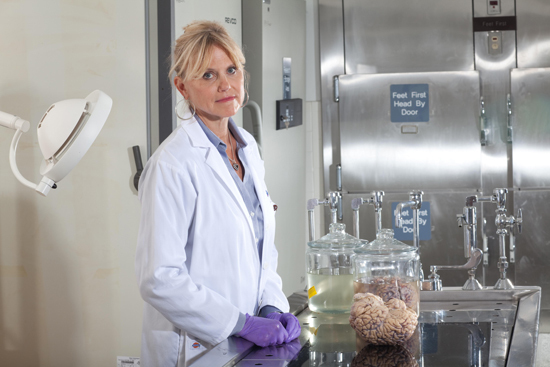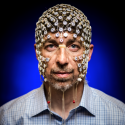Brain injury expert shares insights, research on sports and concussions

Ann McKee has about 300 brains in her “brain bank” at Boston University. “Football is by far the largest source of our donors,” she says.
Photo: Asia Kepka/BU Today
Ann McKee has made national headlines with her research linking football and other sports to a condition called Chronic Traumatic Encephalopathy, or CTE.
McKee, a professor of neurology and pathology at the Boston University School of Medicine, earned her undergraduate degree in zoology at UW–Madison in 1975.
She recently visited campus to talk to UW Health sports medicine staff and to give a well-attended Grand Rounds in Neurology titled, “Football, boxing and the brain.” Here are some highlights of the conversation.
What did you think of former Badger football player Chris Borland’s decision to quit the NFL after one year?
I think he made the right decision. The research shows that it’s the cumulative effect of the hits, and you have to come down on the side of saving your brain. I know Chris and I’ve talked with him. He spoke to several of my colleagues while he was making his decision.
Do you think the emphasis on concussions in sports will prevent CTE?
No. Despite our emphasis on concussion and managing concussion, it’s probably not concussions that are giving rise to this disease. In fact, all our studies indicate that the number of concussions does not correlate with the severity of the CTE. It’s the amount of exposure, the number of years playing sports. We know football players get 1,000 to 1,500 sub-concussive hits per season, even in high school — that’s tens of thousands of hits if they play 10 years. The sub-concussive injury, the asymptomatic injury, is probably very important in developing this disease. CTE has only been found in individuals who sustained repetitive, cumulative traumas.
Former Badger Mike Webster was the first NFL player diagnosed with CTE, yet it seems that the disease is still controversial.
I can’t believe that one of the major issues I deal with are the people who say CTE is not a disease. There are still people out there who believe that I’m misinterpreting the pathology and that these are age-related changes or Alzheimer’s. Unfortunately, CTE is a reality and we need to get over arguing about its existence and get on with figuring out ways to prevent it, identify it during life, and treat it.
What’s the latest on proving that CTE is a real diagnosis?
Last year we had an NIH-sponsored consensus conference on the diagnosis of CTE. To evaluate the pathological criteria for the disease, we sent images of brain pathology from 25 cases of CTE and other brain diseases with tau protein, including Alzheimer’s, progressive supranuclear palsy, primary age-related tauopathy and other diseases to seven expert neuropathologists. The evaluating pathologists were given the pathology images but absolutely no information on the age of the subjects, gender, clinical symptoms, whether or not they were athletes, or even what the gross neuropathological findings were.
It was a very difficult assignment. It took each pathologist about 100 hours to evaluate the 671 slide images, or about four hours per case. In the end, the results showed very good agreement on the diagnoses. About 91 percent of the answers correctly identified the cases with CTE, and that rose to 96 percent when we provided the clinical information. The panel also identified a lesion unique to CTE that only occurs in cases of repetitive head trauma. These results confirm that CTE is a distinct disease — but I had no doubts that I’ll continue to be asked this question.
How many brains are in your brain bank?
We’re now up to about 300 brains. Football is by far the largest source of our donors. We base our criteria on exposure to trauma, either through sports or military service. The reality is that a brain donor population is a very biased population — families don’t think about donating their loved ones’ brains unless they’re concerned about something. In the future, we hope to have more examples of former players who are doing well, because that will help us understand how people resist the disease — what factors, genetic and otherwise, protect them from developing the disorder.
The brain donors in the bank can no longer speak for themselves, and I like to think that I’m telling their story, speaking for individuals who can no longer speak for themselves.
What’s next?
One criticism is that that all our studies to date have been retrospective, after death. We now have funding to do a longitudinal study, evaluating people at high risk for CTE. In the new study we hope to follow 75 NFL players: 25 who are cognitively normal, 25 who are mildly impaired, 25 who are demented.
Do people know they have CTE?
In general, individuals are aware that they can’t think clearly, they can’t get thoughts out of their heads; their thoughts are foggy; they know they’re different. There seem to be two modes of symptom onset: Younger individuals who develop symptoms usually have mood and behavior changes; if a person develops symptoms in their older years, the 50s and 60s, there is generally cognitive decline and memory loss that looks clinically very much like Alzheimer’s disease.
Can anything be done to help them?
My BU colleagues are working on ways to make the diagnosis during life. Once we can clearly identify and monitor the disease during life, we will have a chance to monitor different therapies for efficacy. Clearly, there are many factors that play important roles in why some people develop this disease and why some do not. We think that most likely there are genetic factors that play a role in susceptibility. And importantly, we need to figure out ways to treat individuals, rehabilitate them, so they don’t lead these tragic lives. If we could understand how this disease develops in its very early stages, we would have the best chance for treatment and a cure, so one of the critical groups to study is the individuals in their teens and twenties who have developed CTE.
Related: “Head-On Collision” from On Wisconsin
Tags: brain, health & medicine, UW Athletics



